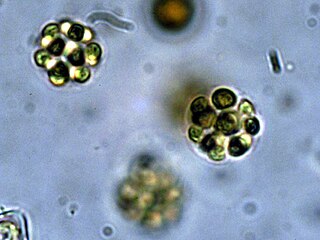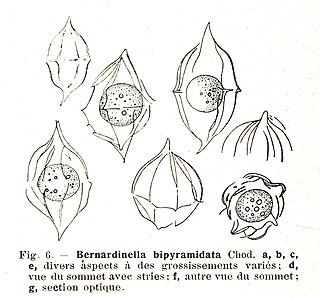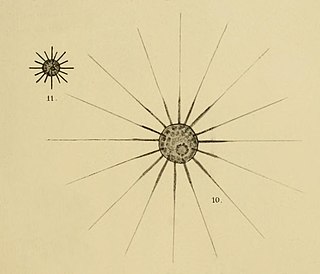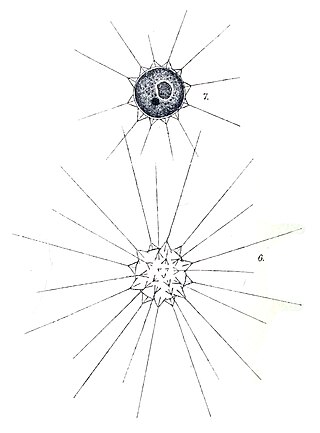
Chlamydocapsa is a genus of green algae, specifically of the Chlorophyceae.
Coelastropsis is a genus of green algae in the family Scenedesmaceae, containing the single species Coelastropsis costata. It is found in freshwater lakes and bogs, usually associated with mosses and filamentous algae. It has been recorded in Europe, Cuba and possibly New Zealand.

Dictyosphaerium is a genus of green algae, in the family Chlorellaceae. It occurs in freshwater habitats around the world and is planktonic. The name comes from the Greek roots diktyon, meaning "net", and sphaira, meaning "ball", referring to its morphology.

Golenkinia is a genus of green algae first described in 1894 by Robert Chodat. The genus is named for the Russian phycologist Mikhail Iljitsch Golenkin. Golenkinia species live in fresh water and are found around the world.

Kirchneriella is a genus of green algae in the family Selenastraceae. It is found in freshwater habitats, as phytoplankton or metaphyton.

Lagerheimia is a genus of green algae in the family Oocystaceae. It is commonly found in freshwater habitats all over the world, although some species are rare and have only been recorded from Europe or the United States.
Palmellopsis is a genus of green algae, specifically of the Palmellopsidaceae. They are either planktonic or attached to substrates in fresh water, or in aeroterrestrial habitats.

Paulschulzia is a genus of green algae, specifically of the family Tetrasporaceae.

Planktosphaeria is a genus of Chlorophyceae of the green algae. It was first described by the phycologist Gilbert Morgan Smith in 1918, with Planktosphaeria gelatinosa as its type species. Species of Planktosphaeria are commonly found in freshwater plankton around the world.

Radiofilum is a genus of green algae in the class Chlorophyceae. It is a freshwater genus; they are often found in soft, boggy or acidic waters.
Schizochlamys is a genus of green algae in the family Schizochlamydaceae. It is found in freshwater habitats and is planktonic.

Sorastrum is a genus of green algae in the family Hydrodictyaceae. It is a component of the phytoplankton of freshwater ponds, lakes, and ditches. Sorastrum is common in tropical to temperate regions of the world, but due to its small size it is often overlooked.
Vitreochlamys is a genus of green algae in the family Chlamydomonadaceae. It is sometimes known by the name Sphaerellopsis, published by Aleksandr Arkadievich Korshikov. However, that name is an illegitimate later homonym, preceded by SphaerellopsisM.C.Cooke. It is commonly found in freshwater habitats.
Spinoclosterium is a genus of green algae, specifically of the Closteriaceae. It is rare, but widely distributed in freshwater regions throughout the world.

Tetrastrum is a genus of green algae (Chlorophyta). It is a common component of the phytoplankton of freshwater habitats, particularly eutrophic and alkaline waters.

Sphaerocystis is a genus of green algae, specifically of the class Chlorophyceae. It is found as plankton in freshwater habitats.

Desmatractum is a genus of green algae, in the order Chlamydomonadales. It is found in freshwater habitats such as ponds, ditches, and bogs as plankton or metaphyton. The genus is cosmopolitan, but some species are very rare.

Acanthosphaera is a genus of green algae, in the family Chlorellaceae. It contains the sole species Acanthosphaera zachariasii, although some sources list a second species, Acanthosphaera tenuissima. It is widely distributed, in freshwater habitats and exists as phytoplankton.

Echinosphaeridium is a genus of green algae, in the family Neochloridaceae. It is found in freshwater habitats, but it is very rare. It has only been recorded a few times since its original discovery in Sweden.

Apiocystis is a genus of algae belonging to the family Tetrasporaceae. It is found attached to freshwater aquatic algae or plants. The species of this genus are found in Europe and Northern America, and are widespread but generally uncommon.














